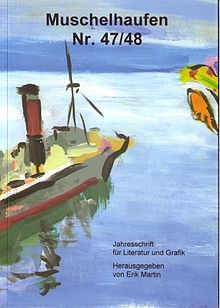Mussel pile (annual publication)
| Clam pile. Annual journal for literature and graphics |
|
|---|---|
| description | Culture magazine |
| language | German |
| First edition | 1969 |
| attitude | 2008 |
| Frequency of publication | yearly |
| Editor-in-chief | Erik Martin |
| editor | Erik Martin |
| Web link | www.muschelhaufen.de |
| ISSN (print) | 0085-3593 |
Muschelhaufen is a German-language annual publication for literature and graphics that attracted attention because of the original connection between art and words. It has been published by Erik Martin in Viersen since 1969 (with a twelve-year break) and has ceased publication with issue 47 / 48-2007 / 2008.
history
The magazine Muschelhaufen was created in the successor of the Grenzwaldfahrers , a small magazine that was published from 1962 to 1969 from the area of the Bündische Jugend in the area of the Kaldenkirchener Grenzwald . When the members scattered all over Germany as a result of their studies and now literature, art and music were the main topics, the magazine was renamed Muschelhaufen in autumn 1969 . The transitional edition No. 15 (1969) had both the title Grenzwaldfahrer or the abbreviation gwf and Muschelhaufen . From 1975 to 1985 the magazine temporarily ceased publication. From 1993 onwards, only first publications were published; each edition contained an extensive picture section. The last edition was 1000 copies, the number of pages between 200 and 230. In addition to the normal subscription, there was an additional special subscription, each of which contained an original art insert signed and numbered from 1 to 350. From 1999 onwards, Muschelhaufen had the subtitle “Annual Journal for Literature and Graphics”. The editorial staff included the artist Martin Lersch and the writer Peter Klusen .
Content and special features
The content of each issue included narrative prose, essays, poetry and reviews, which were combined in various ways with art (illustrations, photo series, independent works). Renowned authors made works available for the first time, but the mussel heap also aimed to provide little-known artists and authors with a high-quality publication platform. For example, Katrin Askan , Uwe Tellkamp and Markus Orths already published in the annual publication before they later received the Ingeborg Bachmann Prize . Particularly comprehensive essays on mail art , German-language prose, literary magazines and poetry publishers came from the permanent editorial staff member Theo Breuer . There were also some special editions, for example about the writer Werner Helwig or about literature from Poland by Dieter Kalka (2001).
The special feature of the annual was the regular extensive "special sections" that were dedicated to a certain topic, for example about "Literature in Greenland " (2005), "Young Danish and Norwegian literature" (2000) or about the artist Gertrude Degenhardt (2007 / 2008). Among other things, often forgotten authors like Fritz Graßhoff or Margot Scharpenberg were given space and new evaluations. “The clam pile has raised real treasures with the special parts. He introduces writers from Greenland with their mostly political and socially critical texts. For most German readers it will be their first contact with what is probably the youngest literary scene in the world. "
Authors and artists
Well-known authors who published in Muschelhaufen included the Austrian poet Ernst Jandl and the Islamic scholar Annemarie Schimmel , who was awarded the Peace Prize of the German Book Trade , as well as Brigitte Kronauer , Günter Kunert , Siegfried Lenz , Christoph Meckel and Guntram Vesper . The annual magazine made a particular effort to rediscover the writers Werner Helwig and Albert Vigoleis Thelen , of whom post-retired texts were also published. Young poets like Jan Wagner or Anja Utler had their say as well as older ones, for example Johannes Kühn or Margarete Hannsmann . The well-known artists who provided works for the annual magazine included the photographer Barbara Klemm , Clemens Weiss , who lives in New York (cover design), the painter Markus Gramer (art supplement), Erwin Heerich , Fritz Schwegler and the book artist Elke Rehder .
Quotes about the clam pile
- Mark Siemons: “A growing number of low-circulation magazines are trying to escape the mainstream with sometimes daring twists. They are called clams, [...] "
- Michael Buselmeier characterized the shell pile as "a good-natured side line of the otherwise tough literature business ."
- Hermann Kurzke : "Shells are the small, neglected treasures on the beach of great literature".
Secondary literature
- Bernhard Fischer; Thomas Dietzel: German literary magazines 1945-1970. A repertory . Edited by the German Literature Archive. De Gruyter Saur, Munich 1992, ISBN 978-3-598-22000-5
- Hermann Kurzke: A breath of fresh air into romance . In: FAZ . January 1, 1994.
- Michael Buselmeier : phases of hunger, migratory birds . In: Frankfurter Rundschau . April 8, 2000.
- Helga Seifert: The last pile of mussels . Rheinische Post, February 24, 2007.
- Markus Orths : Farewell to the clam pile . In: At the bay window . Journal of Literature . No. 53 . Daedalus, Münster 2007, ISBN 978-3-89126-553-6 .
- Paul Wietzorek: Shell heap 2007/2008 . In: The Lower Rhine . No. 3/2007 , ISSN 0342-5673 .
Web links
Individual evidence
- ↑ Sigrid Blomen-Radermacher: A treasure trove for lovers of literature . In: Rheinische Post from November 14, 1997
- ^ Journal database , ISSN 0085-3593
- ↑ Editorial of issue 31/32 (1994)
- ^ Dieter Kalka: Literature from Poland. Special part. In: Musselhaufen (annual publication) . No. 41 , 2001, ISSN 0085-3593 .
- ↑ Sabine Hänisch: Pearls and other highlights . In: Westdeutsche Zeitung of March 1, 2005
- ↑ Be silent in a thousand tongues . In: FAZ , May 21, 1994
- ↑ In the program Literature in Conversation . Saarländischer Rundfunk on March 9, 2000
- ^ FAZ , January 1, 1994
